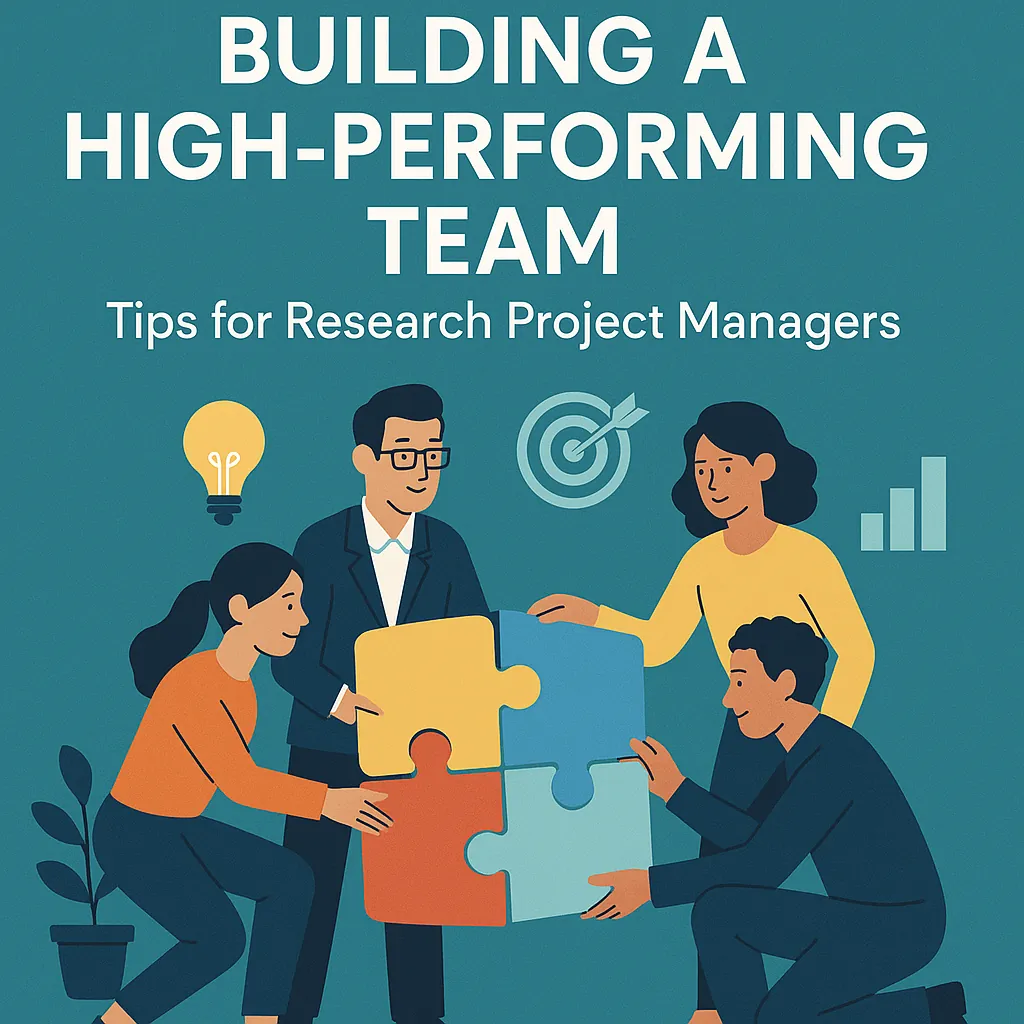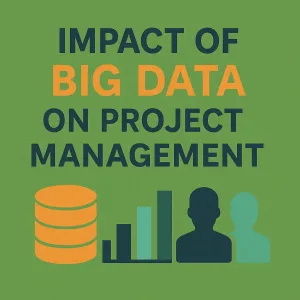Introduction
The role of a research project manager is pivotal. These professionals are responsible for overseeing research initiatives, ensuring that projects are completed on time, within budget, and to the required quality standards. They coordinate various aspects of the project, from planning and execution to monitoring and reporting, while also managing team dynamics and stakeholder expectations. A research project manager must possess a diverse skill set, including leadership, communication, and problem-solving abilities, to effectively guide their teams through complex research landscapes [8].
The significance of high-performing teams in research cannot be overstated. Research projects often involve intricate tasks that require collaboration among team members with varying expertise. High-performing teams are characterized by their ability to work cohesively, leveraging each member’s strengths to achieve common goals. Such teams not only enhance productivity but also foster innovation, as diverse perspectives contribute to creative problem-solving and the generation of new ideas. In research, where the stakes can be high and outcomes uncertain, the effectiveness of the team can directly influence the success of the project [11].
Understanding team dynamics is crucial for research project managers aiming to enhance performance. Team dynamics refer to the interactions and relationships among team members, which can significantly impact collaboration, communication, and overall project outcomes. Positive team dynamics promote trust, open communication, and a shared sense of purpose, leading to improved performance and satisfaction among team members. Conversely, negative dynamics can result in conflict, miscommunication, and decreased morale, ultimately hindering project success. By focusing on fostering healthy team dynamics, research project managers can create an environment that supports high performance and drives successful research outcomes [12][13].
In this section, we will explore practical tips for research project managers to build and maintain high-performing teams, emphasizing the importance of team dynamics in achieving project goals.
Understanding Team Dynamics
Understanding team dynamics is crucial for fostering a high-performing team. Team dynamics refer to the behavioral relationships between members of a team, which can significantly impact the effectiveness and success of a project. Here’s a closer look at the components of team dynamics and their relevance to research projects.
Definition and Relevance of Team Dynamics
Team dynamics encompass the interactions, relationships, and behaviors that occur within a team. These dynamics are essential in research projects as they influence collaboration, communication, and overall team performance. A well-functioning team can enhance creativity, problem-solving, and productivity, which are vital in research settings where innovation and efficiency are paramount. Effective team dynamics can lead to improved project outcomes, while poor dynamics can hinder progress and lead to conflicts.
Stages of Team Development
Understanding the stages of team development is fundamental for research project managers. Bruce Tuckman’s model outlines five key stages that teams typically go through:
- Forming: In this initial stage, team members come together and start to understand their roles. They are polite and tentative as they get to know each other.
- Storming: This stage is characterized by conflict and competition as team members assert their opinions and challenge each other. It is crucial for managers to facilitate discussions to resolve conflicts and establish a collaborative environment.
- Norming: As the team begins to resolve conflicts, they establish norms and develop stronger relationships. Team members start to work more cohesively, which is essential for effective collaboration.
- Performing: At this stage, the team is functioning at a high level. Members are motivated, and the team is focused on achieving its goals. This is where the team can truly excel in their research endeavors.
- Adjourning: Finally, when the project concludes, the team disbands. It is important to reflect on the project’s successes and challenges during this stage to foster learning for future projects.
Factors Influencing Team Dynamics
Several factors can influence team dynamics, and understanding these can help research project managers enhance team performance:
- Communication: Open and effective communication is vital for team success. It fosters transparency, encourages feedback, and helps in resolving misunderstandings. Research project managers should promote a culture of open dialogue to enhance team cohesion.
- Roles: Clearly defined roles and responsibilities help team members understand their contributions to the project. This clarity reduces confusion and ensures that all aspects of the research are covered efficiently.
- Relationships: The interpersonal relationships among team members can significantly impact team dynamics. Building trust and respect within the team can lead to better collaboration and a more positive work environment.
By focusing on these aspects of team dynamics, research project managers can create a supportive and productive atmosphere that enhances team performance and leads to successful project outcomes. Understanding and actively managing these dynamics is essential for navigating the complexities of research projects and achieving high performance.
Identifying Team Strengths and Weaknesses
Understanding the dynamics of your team is crucial for fostering a high-performing environment. By effectively assessing team strengths and weaknesses, research project managers can enhance collaboration, optimize performance, and ultimately achieve project goals. Here are some methods and strategies to guide you in this process:
Methods for Assessing Team Strengths
- Skills Matrix: A skills matrix is a powerful tool that allows project managers to visualize the skills and competencies of each team member. By mapping out individual skills against project requirements, managers can identify who excels in specific areas and where there may be gaps. This visual representation aids in resource allocation and task assignment, ensuring that the right person is matched with the right task [1].
- Personality Assessments: Utilizing personality assessments, such as the Myers-Briggs Type Indicator (MBTI) or the DiSC profile, can provide insights into team members’ working styles and interpersonal dynamics. Understanding these traits helps in forming balanced teams where diverse strengths complement each other, fostering better communication and collaboration [1].
Identifying Areas for Improvement and Potential Challenges
- Regular Check-Ins: Conducting regular one-on-one meetings with team members can help surface potential challenges and areas for improvement. These discussions allow project managers to gauge workloads, stress levels, and any obstacles that may hinder performance. By addressing these issues proactively, managers can create a supportive environment that encourages growth and development [1][2].
- SWOT Analysis: Implementing a SWOT analysis (Strengths, Weaknesses, Opportunities, Threats) can be an effective way to assess both individual and team capabilities. This structured approach helps in identifying not only the strengths and weaknesses of the team but also external opportunities and threats that may impact project success. By understanding these factors, managers can devise strategies to mitigate risks and leverage strengths [2].
Leveraging Individual Strengths for Team Success
- Cross-Training and Mentoring: Encouraging cross-training among team members can enhance overall team performance by allowing individuals to learn from each other’s strengths. Pairing strong employees with those who may need development fosters a culture of collaboration and continuous improvement. This not only builds individual capabilities but also strengthens team cohesion [1][2].
- Recognition and Empowerment: Recognizing and celebrating individual contributions can significantly boost morale and motivation. When team members feel valued for their unique strengths, they are more likely to engage fully in their roles. Empowering individuals to take ownership of their tasks and encouraging them to utilize their strengths can lead to innovative solutions and improved project outcomes [1][2].
By focusing on these strategies, research project managers can effectively assess their team’s capabilities, identify areas for improvement, and leverage individual strengths to build a high-performing team. This proactive approach not only enhances team dynamics but also drives project success in the competitive field of research.
Fostering Open Communication
Fostering open communication is paramount to building a high-performing team. Effective communication not only enhances team dynamics but also significantly contributes to the overall success of research initiatives. Here are some key points to consider:
Importance of Open and Honest Communication
- Psychological Safety: Creating an environment where team members feel safe to express their thoughts and concerns is crucial. When individuals believe their input is valued, they are more likely to share innovative ideas and constructive feedback, which can lead to improved project outcomes [11].
- Enhanced Collaboration: Open communication encourages collaboration among team members. It allows for the sharing of insights on effective strategies and highlights areas where additional support may be needed, ultimately enhancing team effectiveness [2][6].
Tips for Encouraging Dialogue and Feedback
- Regular Meetings: Hold consistent team meetings to discuss progress, challenges, and ideas. This practice not only keeps everyone informed but also provides a platform for team members to voice their opinions and suggestions [1][7].
- Active Listening: Encourage team leaders to practice active listening. This involves fully engaging with what team members are saying, asking clarifying questions, and acknowledging their contributions. This approach fosters a culture of respect and understanding [1][6].
- Anonymous Feedback Options: Implementing anonymous feedback mechanisms can help team members express their thoughts without fear of judgment. This can be particularly useful for addressing sensitive issues or gathering honest opinions on team dynamics [1].
Tools and Platforms for Effective Communication
- Shared Dashboards and Wikis: Utilizing collaborative tools such as shared dashboards or wikis can enhance transparency and keep everyone on the same page. These platforms allow team members to access project updates, share documents, and track progress collectively [8][9].
- Communication Apps: Consider using communication applications like Slack or Microsoft Teams, which facilitate real-time messaging and file sharing. These tools can help maintain ongoing conversations and ensure that team members can easily connect, regardless of their physical location [10].
By prioritizing open communication, research project managers can cultivate a high-performing team that is engaged, collaborative, and equipped to tackle the complexities of research projects. Emphasizing these practices not only enhances team dynamics but also drives project success through improved performance and innovation.
Building Trust and Collaboration
Fostering a high-performing team hinges significantly on the establishment of trust and collaboration. Trust is not merely a soft skill; it is a foundational element that enables teams to function effectively and achieve their objectives. Here are some key points to consider when building trust within your research team:
Importance of Trust in Fostering a Collaborative Environment
- Foundation of Team Dynamics: Trust is essential for creating a cohesive team. A project team that lacks trust often operates as a mere collection of individuals rather than a unified group. This can lead to missed deadlines, unresolved conflicts, and ultimately, disappointing results. When team members trust one another, they are more likely to communicate openly, share ideas, and support each other in achieving common goals [2][3].
- Impact on Performance: Research indicates that quality communication, which is rooted in trust, significantly enhances collaboration among project members. This, in turn, influences the overall success of project management efforts. Teams that prioritize trust are better equipped to navigate challenges and innovate effectively [3][4].
Activities and Practices that Build Trust
- Team-Building Exercises: Engaging in team-building activities can significantly enhance interpersonal relationships among team members. These exercises foster a sense of belonging and mutual respect, which are crucial for building trust. Activities can range from informal social gatherings to structured workshops focused on collaboration and communication skills [6][15].
- Establishing Shared Goals: Creating a shared vision and common objectives is vital for aligning team efforts. When team members understand and commit to collective goals, it cultivates a sense of accountability and encourages collaboration. Transparency in communication about these goals further strengthens trust within the team [7][8].
- Training and Development: Investing in training programs that focus on collaborative skills and active listening can enhance team dynamics. Workshops that emphasize conflict resolution and effective communication can equip team members with the tools they need to navigate interpersonal challenges, thereby reinforcing trust [6][15].
Role of Conflict Resolution in Maintaining Trust and Collaboration
- Addressing Conflicts Proactively: Conflicts are inevitable in any team setting, but how they are managed can either build or erode trust. Research project managers should encourage open dialogue and active listening to understand differing perspectives. This approach not only resolves conflicts but also demonstrates respect for each team member’s viewpoint, which is essential for maintaining trust [5][12].
- Empathy and Understanding: Practicing empathy during conflicts can help team members feel heard and valued. By actively listening and striving to understand each other’s positions, project managers can foster an environment where trust is preserved, even in challenging situations [5][12].
Setting Clear Goals and Expectations
Establishing clear goals and expectations is paramount for fostering a high-performing team. This section will delve into the significance of setting SMART goals, the importance of clarity in roles and responsibilities, and effective goal-setting strategies tailored for research projects.
The Significance of SMART Goals
Setting SMART goals is a foundational practice that can significantly enhance team dynamics and performance. SMART stands for:
- Specific: Goals should be clear and specific, allowing team members to understand exactly what is expected of them. For instance, instead of stating “improve research quality,” a specific goal would be “increase the accuracy of data collection by 20% within the next quarter.”
- Measurable: Goals must be quantifiable to track progress effectively. This could involve metrics such as the number of experiments completed or the percentage of tasks finished on time.
- Achievable: While goals should be challenging, they must also be realistic. Setting unattainable goals can lead to frustration and decreased morale. For example, aiming to publish three research papers in a year may be achievable for a well-resourced team, but not for one with limited capacity.
- Relevant: Goals should align with the broader objectives of the research project and the organization. This ensures that team efforts contribute meaningfully to the overall mission.
- Time-bound: Establishing deadlines creates a sense of urgency and helps prioritize tasks. For instance, setting a goal to complete a literature review by the end of the month provides a clear timeframe for accountability.
By implementing SMART goals, research project managers can enhance focus and alignment within their teams, ultimately leading to improved project outcomes and team performance [1].
Clarity in Roles and Responsibilities
Another critical aspect of enhancing team performance is ensuring clarity in roles and responsibilities. When team members understand their specific roles, it minimizes confusion and overlap, allowing for more efficient collaboration. Here are some benefits of clearly defined roles:
- Enhanced Accountability: When individuals know their responsibilities, they are more likely to take ownership of their tasks, leading to higher accountability and productivity.
- Improved Communication: Clarity in roles facilitates better communication among team members, as they can easily identify who to approach for specific issues or tasks.
- Increased Collaboration: Understanding each member’s strengths and responsibilities fosters a collaborative environment where team members can support one another effectively.
Effective Goal-Setting Strategies in Research Projects
To further guide research project managers in establishing clear goals, here are some effective strategies:
- Involve the Team: Engage team members in the goal-setting process. This not only fosters a sense of ownership but also ensures that the goals are realistic and aligned with the team’s capabilities.
- Regular Check-ins: Schedule frequent one-on-one check-ins to discuss progress, address challenges, and adjust goals as necessary. This ongoing communication helps maintain alignment and motivation.
- Utilize Visual Tools: Implement visual project management tools, such as Gantt charts or Kanban boards, to track goals and progress. These tools can provide a clear overview of tasks and deadlines, enhancing transparency and accountability.
- Celebrate Milestones: Recognize and celebrate the achievement of milestones. This not only boosts morale but also reinforces the importance of working towards the established goals.
Encouraging Continuous Learning and Development
Fostering a culture of continuous learning and development is essential for building a high-performing team. This approach not only enhances individual skills but also strengthens team dynamics, ultimately leading to improved project outcomes. Here are some key points to consider:
- Importance of Ongoing Training and Skill Development: Continuous learning is vital for research project managers and their teams to stay competitive and innovative. As project demands evolve, so too must the skills of the team members. Regular training sessions can help identify and address learning gaps, ensuring that the team is equipped with the latest methodologies and tools necessary for success [1][13]. This commitment to skill enhancement not only boosts individual confidence but also contributes to the overall effectiveness of the team.
- Methods for Fostering a Learning Environment: Creating a supportive learning environment can be achieved through various methods. Organizing workshops and training sessions allows team members to engage with new concepts and practices actively. Additionally, implementing mentorship programs can facilitate knowledge transfer from experienced members to newer ones, fostering a sense of community and collaboration [2][3]. Regular one-on-one meetings can also serve as a platform for discussing personal development goals and tracking progress, which is crucial for maintaining motivation and accountability [7][6].
- Benefits of Knowledge Sharing and Collaboration with External Experts: Encouraging knowledge sharing within the team is a powerful strategy for enhancing collaboration and innovation. Techniques such as pair programming, brainstorming sessions, and task splitting can promote a collaborative spirit and allow team members to learn from one another [2]. Furthermore, collaborating with external experts can provide fresh perspectives and insights that enrich the team’s understanding and approach to research challenges. This external collaboration not only broadens the team’s knowledge base but also fosters adaptability and growth, essential traits in the fast-paced research environment [11][15].
By prioritizing continuous learning and development, research project managers can cultivate a high-performing team that is not only skilled but also adaptable and innovative. This commitment to growth will ultimately lead to more successful project outcomes and a more engaged and motivated team.
Measuring Team Performance
Understanding and enhancing team dynamics is crucial for achieving project goals. A well-structured approach to measuring team performance can significantly impact the success of research initiatives. Here are some key points to consider:
Key Performance Indicators (KPIs) for Research Teams
Establishing clear Key Performance Indicators (KPIs) is essential for tracking the effectiveness of research teams. KPIs provide measurable values that reflect the team’s performance in relation to project objectives. Some relevant KPIs for research teams include:
- Project Milestones: Tracking the completion of key project phases can help assess whether the team is on schedule.
- Quality of Deliverables: Evaluating the quality of research outputs, such as publications or reports, can indicate the team’s effectiveness.
- Collaboration Metrics: Measuring the frequency and quality of team interactions can provide insights into team dynamics and communication effectiveness.
- Feedback Scores: Collecting feedback from team members and stakeholders can help gauge satisfaction and engagement levels within the team.
By utilizing these KPIs, research project managers can gain a clearer picture of their team’s performance and identify areas for improvement [1][14].
Methods for Gathering Feedback and Assessing Team Dynamics
To effectively measure team performance, it is vital to implement various methods for gathering feedback and assessing team dynamics. Some effective strategies include:
- Surveys and Questionnaires: Regularly distributing surveys can help collect quantitative and qualitative data on team members’ experiences and perceptions.
- Performance Reviews: Conducting structured performance reviews allows for in-depth discussions about individual contributions and team dynamics.
- Team Reflection Sessions: Facilitating discussions where team members reflect on their experiences can uncover insights into team cohesion and collaboration.
- Observation: Actively observing team interactions during meetings and collaborative sessions can provide valuable context regarding team dynamics.
These methods not only help in assessing performance but also foster an environment of open communication and continuous improvement [2][4][12].
Adjusting Strategies Based on Performance Data
Once performance data is collected, it is crucial for research project managers to analyze this information and adjust strategies accordingly. Here are some steps to consider:
- Identify Performance Gaps: Use the data to pinpoint areas where the team is underperforming and develop targeted strategies to address these gaps.
- Set New Goals: Based on the insights gained, establish new, realistic goals that align with the team’s capabilities and project objectives.
- Implement Training and Development: If specific skills are lacking, consider providing training opportunities to enhance team members’ competencies.
- Foster a Supportive Environment: Encourage a culture of feedback and support, where team members feel comfortable discussing challenges and seeking assistance.
By continuously monitoring performance and being willing to adapt strategies, research project managers can cultivate a high-performing team that is well-equipped to meet the demands of their projects [3][8][14].
Conclusion
The significance of fostering strong team dynamics cannot be overstated. A cohesive and motivated team is essential for navigating the complexities of research projects, ultimately leading to successful outcomes. Here are the key takeaways to consider:
- Importance of Team Dynamics: Effective team dynamics are crucial for the success of research projects. They enhance collaboration, improve communication, and foster a supportive environment where team members can thrive. By prioritizing the well-being of individual team members and the group as a whole, research project managers can create a culture that encourages innovation and productivity [3][7].
- Implementation of Strategies: Research project managers are encouraged to actively implement the strategies discussed throughout this blog. This includes setting clear goals, maintaining open lines of communication, and recognizing the unique expectations of various stakeholders. By strategically preparing and mapping out projects, managers can ensure that their teams are aligned and focused on achieving common objectives [4][8].
In conclusion, by focusing on team dynamics and actively implementing effective management strategies, research project managers can significantly enhance their team’s performance and drive successful project outcomes. Let’s work together to create environments where research teams can excel!
Find out more about Shaun Stoltz https://www.shaunstoltz.com/about/.
This post was written by an AI and reviewed/edited by a human.



